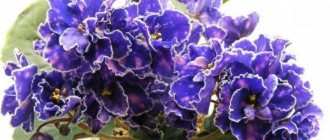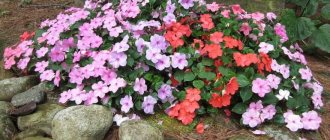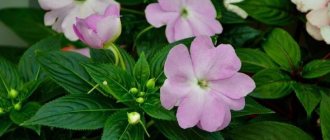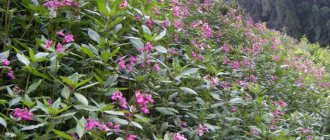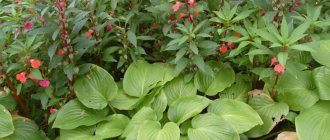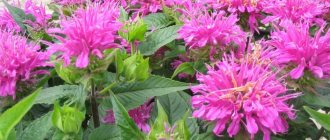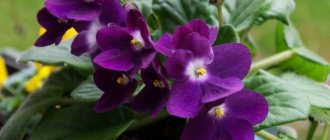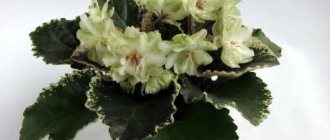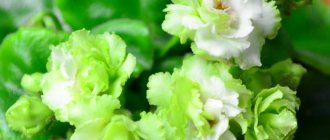In fact, ampelous balsams do not exist. If translated from German, the word Ampel is a hanging (hanging) flower vase. And they began to call balsam ampelous, because the stems of some hybrids bend so much that the pot has to be suspended. This is how they began to call the balsam ampelous. And growing balsam from seeds is not much different from growing ordinary balsam.
History and description
There is no exact information regarding the origin of balsam. It is only known that its homeland and habitat are the subtropics of North America and Africa. Impatiens was brought to Europe in 1596, after which it gained great popularity. Waller's terry balsam is considered the most decorative. He is the “parent” of many hybrids. Impatiens is a perennial plant, but is often cultivated as an annual.
Waller's balsam is different:
- Abundant flowering.
- Juicy, brittle branched stem up to 60 cm high.
- Reddish-brown leaves.
- Shoots are 30 cm long.
Inflorescences appear early. Flowering lasts throughout the year. There are so many flowers that they cover all the leaves. The flowers are 5 cm in diameter. They are solitary or collected in inflorescences. They consist of 5 sepals and a five-membered corolla, connected in pairs or individual petals.
The peduncle is long. The fruit is a capsule. The root system is powerful and grows into drainage holes when there is not enough space.
Interesting Facts
There is an opinion that the color of balsam buds can influence a person with its energy flows:
- orange – awakens sexuality;
- red – increases physical activity;
- purple – stimulates mental abilities;
- white – generates spirituality;
- pink – evokes emotion.
Appearance and features
Balsam belongs to the balsam family. The leaves have wavy edges and droplets form at the tips when humidity is high. The flowers are located in the axils of the leaves and have a variety of colors:
- White.
- Red.
- Orange.
- Lilac.
- Pink.
The flowers are bicolor and have a spot in the central part. There are terry hybrids with multi-colored leaves. The crop blooms from early June to late September in open ground.
At the end of flowering, green fruits ripen, from which seed pods are formed. Balsam has a peculiarity: if you touch a dry box, the seeds scatter to the sides.
This beautiful and unpretentious plant has many varieties and is actively used for growing both at home and in the garden. Below you will find descriptions, characteristics and features of growing such species: Garden, Wild, New Guinea, Tom Samb, Ferruginous or Zheleznokosny.
Photo of the plant
Here you can see a photo of balsam:
Popular varieties
Breeders have developed several varieties of hanging balsam. The most popular are:
— Tumbler Scarlet: the flowers of this variety grow up to 5 cm in diameter and are bright red
- White toggle switch: white flowers of the same diameter
— toggle switch Rose: as the name suggests, this is an ampelous balsam with pink flowers
— Wallera Atena Coral pink – double scarlet flowers
All varieties whose names begin with Waller have double flowers.
— Wallera Atena Red Flash - double flowers of red color with white splashes.
And many other varieties that, with proper care, all varieties produce a gorgeous flowering ball. Look at the photo.
To give the balsam a more distinct ball shape, you can slightly trim the plant by cutting off the excess length of the shoots.
With its beauty, balsam will enliven any environment. Show your imagination: using a special flower stand or ordinary hooks, you can create an extraordinary cascading flower arrangement from different varieties. And this beauty will delight you for a long time. After all, balsam blooms from June until the first frost (almost until November).
In addition, ampelous balsam successfully complements the beauty of petunia and verbena blossoms.
But balsam is not only for apartments. This plant will creatively decorate terraces, verandas, balconies, flower beds...
Even in the absence of flowering, balsam with its solid greenery looks gorgeous.
And when flowering is over, all flower stalks are cut off, and the plant itself is put in a cool place with a temperature of up to +15, and watered moderately. New shoots will appear in February. When this happens, the plant needs to be returned to a warm place and watering increased.
Landing
Lighting and location
When planting a crop in open ground, you must choose a sunny , slightly shaded place. At home, balsams are placed on eastern and western window sills.
Reference. Impatiens is unpretentious to lighting and can even grow in the corner of a room.
Soil requirements
Planting of ampelous balsam is carried out in a loose and slightly acidic substrate. Acidity within 5.8-6 pH. To prepare the soil mixture yourself, take the following components in equal quantities:
- River sand.
- Leafy soil.
- Peat.
- Vermiculite.
You can purchase ready-made substrate at a flower shop.
Rules
Seeds are prepared for seedlings in mid-March. They are pre-disinfected in a solution of potassium permanganate. Algorithm for planting seeds:
Prepare containers with substrate and place planting material at a distance of 2-3 cm from each other.- Press the seeds a little into the ground and sprinkle with sand.
- Lightly water the soil.
- Cover the container with seedlings with glass or film to retain heat.
The container with seedlings is placed in a warm place with diffused light. Temperature for germination is +20-25 degrees. Direct sunlight is harmful to balsam.
Every day you need to remove the glass or film for ventilation. Make sure that the soil does not dry out. When 3 leaves appear, seedlings are picked.
Choose a pot that is not too large. Balsam feels comfortable even in cramped spaces. Drainage must be placed in the container - for example, expanded clay. Pour the substrate and place the seedling.
After planting, the plant requires daily watering. Waller's balsam and its hybrids are heat-loving crops. Planting in open ground is carried out no earlier than June-July. The seedlings are placed at a distance of 25 cm from each other.
Balsam F1 Athena appleblossom, terry
Taking care of every client!
Fast, comfortable and inexpensive!
It’s very easy to get lost in such a large assortment of all kinds of products, and of course you want so many things! But it happens that it is not possible to order everything at once.
So that you don’t lose the products you like and don’t waste time searching for them, we have created a convenient section for you where you can save the items you like.
Now you can create your own “Family Garden”.
On the page of our new section you have the opportunity to create convenient lists for you where your plans for future plantings will be stored. Sort products into lists by price, culture, planting time, or any property convenient for you.
Did you like something but want to order it later? Create a list, save the selected items there and, when the time comes, click the “all items to cart” button. The total amount of the future order will be shown in the lower right corner.
To get started, use the already created “Favorites” list and save all the items you like to it. If you want to create a list with your own name, just click the “Add new list” button. Give it any name that will help you navigate, for example, “Seeds for 2016”, “My Club”, “Summer Flowerbed”, etc. And when the time comes, in a few clicks order all the necessary goods, for example, for your winter garden.
Now viewing the detailed description of the product, you can click the “Add to My Family Garden” button, and the product you like will be saved in the folder of your choice.
Easy, fast, convenient! Happy shopping!
To add a product to My Family Garden, you must go to the product page.
Next, you need to follow the Add to My Family Garden link.
In the additional window that appears, you must select the list to which you would like to add the current product. You can select New List by giving it a name. After selecting the list, you must click on the “Ok” link.
My Family Garden On the section page you can view all the products you have added, as well as the lists you have created.
From here you can add items to your cart individually:
And also the whole list:
You can also remove a product from the selected list:
Or clear the entire list of products:
To completely delete the list, use the following link:
Create lists on various topics. Examples of names can be very different: “My future summer flowerbed”, “For the dacha”, “Apple orchard” and many others. Do you know exactly what fruit and berry seedlings you will order? So call the list “Delicious”, adding your favorite varieties there. And when the time comes, order the entire list in just a few steps.
We have done everything to make My Family Garden as convenient and easy to use as possible!
Source: www.ncsemena.ru
Flower care
In room conditions
Impatiens love moderate humidity. In hot weather they need to be sprayed so that the flowers do not fade.
Important! Water should not get on the flowers. Only the leaves are sprayed.
The temperature in summer is plus 25-26 degrees. In winter - no lower than plus 10-12 degrees. Temperature conditions cannot be changed suddenly if flowerpots with plants are in the garden. They are brought into the house before the cold weather sets in. Ampel balsams need bright sunlight, but they must be protected from direct rays to avoid leaf burns.
Irrigation features:
- Moisturize twice a day - morning and evening.
- Use only settled or boiled water. Definitely warm.
Do not allow the soil ball to dry out. If the soil is dry, place the container with the flower in a large bowl of water and leave until the soil gets wet.- In summer, provide abundant watering, in winter - reduce moisture.
- Make sure that there is no stagnation of water - the root system will begin to rot.
If there is a lack of liquid, the development of balsam slows down , the flowers fade and fall off.
Decorative crops are fed every 2 weeks from April to August. Use special fertilizers for flowering plants. For example, Kemira. It contains iron, copper, potassium, phosphorus, magnesium. For abundant flowering, use Cristanol once a week (1 tbsp. l / 5 l of water).
Transfer
The culture is transplanted into another pot when the root system does not fit into the drainage holes. The procedure is carried out in April or May. If the rhizomes feel comfortable, it is not necessary to replant the plant. After replanting, pruning is done: long stems are shortened and the tops are pinched.
In the open ground
Rules for caring for garden balsams:
- Regular watering in the evening, especially in the heat.
- Mulching the soil to retain moisture.
- Weeding and removing wilted flowers.
Phosphorus and potassium fertilizers are applied twice a month and fed with an ash solution. It is advisable to use liquid fertilizer for the leaves. In order for the bush to have a beautiful shape, you need to regularly pinch the tops of young branches.
Before frost sets in, balsams are dug up and planted in a pot. They will continue to bloom at home. At the end of budding, the shoots are cut off and the plant is placed in a cool room with a temperature of no more than + 15 degrees. The dormant period lasts during January and February. At the end of February, shoots already appear on the balsam. The flower is watered intensively and transferred to warmth.
When to take impatiens to the dacha?
We all know what summer is like in Siberia - snow can fall at the end of May, and hail can fall in June. Therefore, there is no need to rush to take balsams to the dacha. Only when truly summer weather sets in, and the threat of night frosts has long passed, can you place the pots in partial shade or in diffused light.
In the summer of 2022, the height of the snow cover that fell once in one morning was about 15 cm! It was May 19th. Then there were cold weather with night temperatures of a maximum of +5+10. At this time, I tried to bring a couple of bushes to the dacha, already planted and well established in pots. I placed them in a fairly warm house, came to water them regularly, and moderately, without flooding, but this did not save the young impatiens from the cold, and after a week of cold nights the plants drooped irrevocably.
Therefore, I decided not to rush anymore and brought the remaining balsams to the dacha only at the beginning of June, when at night it was at least +15+17.
Diseases and pests
In winter, impatiens is susceptible to fungal diseases, gray mold in particular. The plant is removed from the pot, the roots are cleaned and transplanted into another container with a new substrate.- At elevated temperatures and low humidity, flowering stops and the leaves wither. Dry indoor air causes buds to fall off. Lack of light affects the color of the leaves. Impatiens lose their decorative appearance - the shoots become very elongated.
- Bacteriosis (watery spots on shoots and leaves) develops due to contaminated, over-fertilized soil; high temperature. Spots cover all the leaves and the plant dies. You need to fight the disease at the first signs. The flower is sprayed with Bordeaux mixture.
- If the room humidity is low, the flower may be affected by spider mites. The leaves curl and fall off over time. To combat the pest, the drugs Neoron and Actellik are used. The appearance of whiteflies is signaled by yellowing of the leaves. Treatment is carried out by Fufaron, Decis.
To prevent diseases and pests, you should adhere to the above rules for caring for the plant.
Content problems
Chandelier balsam, the cultivation of which we are discussing today, can cause some difficulties if not properly cared for:
- Lack of light in the room - the flowers turn pale.
- A sharp cold snap, dry or cold air, low humidity, dry soil - flowering stops, flowers and buds fall off.
- A cramped pot, lack of nutrients in the soil - plant growth slows down.
- Low air temperature, insufficient watering - drooping leaves.
- Insufficient lighting, cold air, waterlogged soil - the roots and base of the stems rot.
Features of reproduction
Balsam is grown from seeds or propagated by shoot cuttings. Vegetative propagation consists of the following actions:
- Choose a healthy shoot 8-10 cm and cut it with a sharp knife.
- Place the cutting in a container with water and place it in a bright place - on a windowsill.
- After the roots appear, the cuttings are planted into small containers (10 cm in diameter).
When rooting is carried out in the spring, a flowering plant will form from the shoot in the summer. During autumn rooting, more heat and light will be required.
Thus, ampel balsam is an unpretentious decorative crop. It is grown at home in pots. At the beginning of summer, you can plant it in the garden in a semi-shaded area. With the onset of cold weather, the plants are dug up and transplanted back into the pot. In order for balsams to bloom wildly, it is important to follow the rules of care. You cannot replant the crop during flowering and place it near heating appliances.
Growing petunia from seeds
This flower has very small seeds. In order for them to sprout, they need to be provided with nutritious soil. The soil should be light, loose and neutral acidity.
Important! Petunia seeds are sown from February to April. However, March is considered the ideal time
Plants planted this month will produce abundant flowering in June.
For sowing, a shallow wide container is suitable, which is filled with soil, leaving a small (about 1 cm) side. In order for the seeds to be evenly distributed over the surface, they need to be mixed with dry sand. After sowing, the soil should be moistened with a spray bottle.
The container is covered with glass or film and placed in a room where the temperature is not lower than +20 degrees. It is important not to forget to spray the soil. You can place the container in a tray with water, from which moisture will gradually flow into the soil
The first shoots appear within a week. The sprouts must be ventilated by opening the greenhouse for a while, otherwise they will be susceptible to various diseases.
Today, stores sell special granules in which manufacturers place petunia seeds. These granules are a coating of nutrients, so achieving a good harvest with their help will be much easier. In addition, it is easier to plant such “seeds” in the soil, since they are larger in size than the seed itself. The main thing is not to let this granule dry out, as this will destroy the seed and it will not germinate.
Experts often recommend planting granules in peat tablets. For petunia, the best option is tablets whose diameter does not exceed 4 cm. Growing a flower in such an environment is not at all difficult:
- Before planting, the peat tablet is soaked in water for 2 hours. You need to wait until it swells completely. If necessary, you can add water, and if there is excess left, drain it.
- One granule is placed into each tablet using a match.
- After planting, the granules are sprayed with water until their shell turns into mush.
- After 5 minutes, the shell is carefully smeared.
- The tablets are covered with film.
Petunia bush
Selection of ampelous petunia seeds
When choosing petunia seeds, you should never rely on the picture on the seed package. Manufacturers often embellish their products, so expectations and reality can differ significantly from each other.
When choosing seeds, you should focus on the following indicators:
Variety You need some unusual specimen, for example, such as a large-flowered terry petunia or species that have a lush cap, this can be multiflora or surfinia. Color. You can focus on your favorite shades or those that will harmoniously fit into the interior or flower arrangement. Features of the species. There are plants that bloom later, and others earlier. The varieties also differ in their resistance to bad weather conditions. Expiration dates. Petunia seeds are very sensitive, so if they were collected a long time ago, their similarity will be deplorable. Manufacturer
There are companies that are more conscientious about the quality of their products, and there are also those that do not pay much attention to this. Before purchasing, it is better to read several reviews left by experienced flower growers, then it will be easier to decide on the manufacturer.
